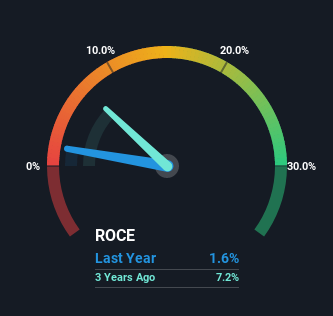- United Kingdom
- /
- Hospitality
- /
- LSE:MAB
The Returns On Capital At Mitchells & Butlers (LON:MAB) Don't Inspire Confidence
If we're looking to avoid a business that is in decline, what are the trends that can warn us ahead of time? When we see a declining return on capital employed (ROCE) in conjunction with a declining base of capital employed, that's often how a mature business shows signs of aging. This combination can tell you that not only is the company investing less, it's earning less on what it does invest. On that note, looking into Mitchells & Butlers (LON:MAB), we weren't too upbeat about how things were going.
Understanding Return On Capital Employed (ROCE)
For those that aren't sure what ROCE is, it measures the amount of pre-tax profits a company can generate from the capital employed in its business. To calculate this metric for Mitchells & Butlers, this is the formula:
Return on Capital Employed = Earnings Before Interest and Tax (EBIT) ÷ (Total Assets - Current Liabilities)
0.016 = UK£75m ÷ (UK£5.2b - UK£616m) (Based on the trailing twelve months to April 2022).
So, Mitchells & Butlers has an ROCE of 1.6%. In absolute terms, that's a low return and it also under-performs the Hospitality industry average of 4.1%.
See our latest analysis for Mitchells & Butlers

In the above chart we have measured Mitchells & Butlers' prior ROCE against its prior performance, but the future is arguably more important. If you're interested, you can view the analysts predictions in our free report on analyst forecasts for the company.
What The Trend Of ROCE Can Tell Us
We are a bit worried about the trend of returns on capital at Mitchells & Butlers. About five years ago, returns on capital were 7.0%, however they're now substantially lower than that as we saw above. Meanwhile, capital employed in the business has stayed roughly the flat over the period. This combination can be indicative of a mature business that still has areas to deploy capital, but the returns received aren't as high due potentially to new competition or smaller margins. So because these trends aren't typically conducive to creating a multi-bagger, we wouldn't hold our breath on Mitchells & Butlers becoming one if things continue as they have.
The Bottom Line On Mitchells & Butlers' ROCE
In summary, it's unfortunate that Mitchells & Butlers is generating lower returns from the same amount of capital. In spite of that, the stock has delivered a 2.9% return to shareholders who held over the last five years. Regardless, we don't like the trends as they are and if they persist, we think you might find better investments elsewhere.
One more thing: We've identified 2 warning signs with Mitchells & Butlers (at least 1 which is a bit unpleasant) , and understanding these would certainly be useful.
If you want to search for solid companies with great earnings, check out this free list of companies with good balance sheets and impressive returns on equity.
New: Manage All Your Stock Portfolios in One Place
We've created the ultimate portfolio companion for stock investors, and it's free.
• Connect an unlimited number of Portfolios and see your total in one currency
• Be alerted to new Warning Signs or Risks via email or mobile
• Track the Fair Value of your stocks
Have feedback on this article? Concerned about the content? Get in touch with us directly. Alternatively, email editorial-team (at) simplywallst.com.
This article by Simply Wall St is general in nature. We provide commentary based on historical data and analyst forecasts only using an unbiased methodology and our articles are not intended to be financial advice. It does not constitute a recommendation to buy or sell any stock, and does not take account of your objectives, or your financial situation. We aim to bring you long-term focused analysis driven by fundamental data. Note that our analysis may not factor in the latest price-sensitive company announcements or qualitative material. Simply Wall St has no position in any stocks mentioned.
About LSE:MAB
Mitchells & Butlers
Engages in the management of pubs, bars, and restaurants in the United Kingdom and Germany.
Solid track record and good value.
Similar Companies
Market Insights
Community Narratives



